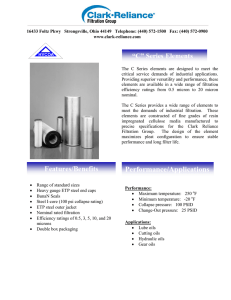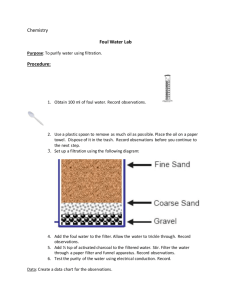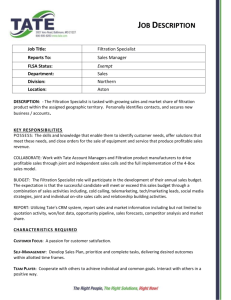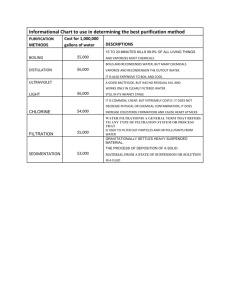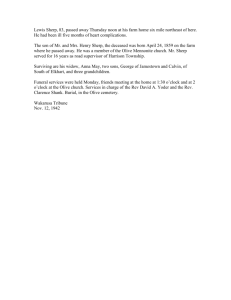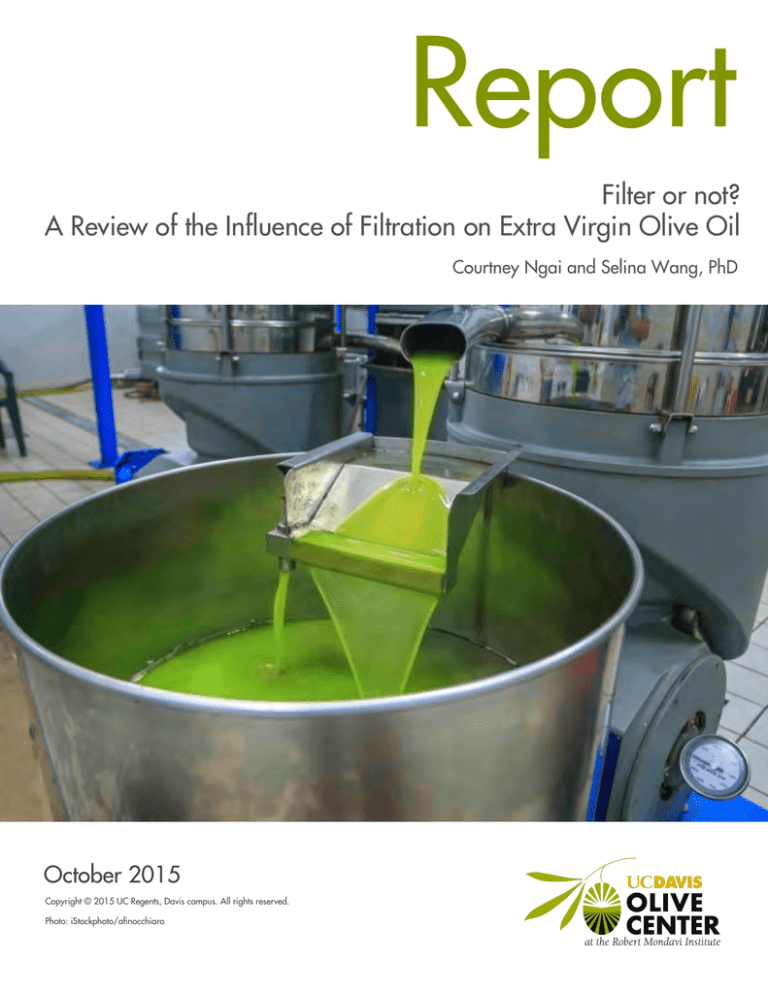
Report
Filter or not?
A Review of the Influence of Filtration on Extra Virgin Olive Oil
Courtney Ngai and Selina Wang, PhD
October 2015
Copyright © 2015 UC Regents, Davis campus. All rights reserved.
Photo: iStockphoto/afinocchiaro
Filter or Not? ­ UC Davis Olive Center, October 2015
Filter or Not?
A Review of the Influence of Filtration on Extra Virgin Olive Oil
Courtney Ngai and Selina W ang, PhD
Executive Summary
Filtration removes suspended solids and moisture in olive oil before storage and can produce positive, negative or
neutral effects on the parameters of stability, phenolics, volatiles, sensory, appearance, pigments and shelf life. The
impact of filtration on the oil depends on the initial chemical and sensory profile, varietal of the oil, filtration system
and storage conditions. Regardless of method, filtration will require additional expenses for equipment, labor, and
processing time. After reviewing the current literature on filtration research, we found that there is no simple answer
to the question of whether to filter or not. While the research lacks consensus regarding many of the effects of
filtration as summarized in Figure 1, there are some general areas of agreement as summarized in Figure 2.
Figure 1. Filtration can have positive and negative effects on key parameters of extra virgin olive oil quality
1 Filter or Not? ­ UC Davis Olive Center, October 2015
Figure 2. Areas of general agreement on extra virgin olive oil filtration
Background
Extra virgin olive oil (EVOO) is produced solely through mechanical means, which includes washing of the olives,
malaxing (or kneading) of the olive paste, centrifuging to separate the oil from the olive paste, and decanting of the
oil before storage. While EVOO can be consumed without further treatment, some processors filter the oil to remove
suspended solids or moisture that can promote oil deterioration. However, quantitative and qualitative changes
occur during and after filtration, especially on the minor components that are very important for the oil quality and
its health benefits.
More than 98 percent of olive oil (by weight) is triacylglycerols while the remainder, known as minor components, is
made of phenols, pigments, volatiles and other non-glyceride chemical compounds. There are many agronomic and
technological factors that affect the composition and concentration of these minor components, including olive fruit
ripeness, fruit quality, milling conditions, malaxation (time, temperature, and oxygen exposure), centrifugation, and
storage conditions.
2 Filter or Not? ­ UC Davis Olive Center, October 2015
There are several types of filter aids for removing suspended solids and moisture, and within the same filter aids,
there are often additional options (e.g., paper filtering with or without Na2SO4). The different filtering systems are
briefly described below:
Filters to remove moisture. In olive oil with a high moisture content, traditional filter presses such as
cotton, paper or anhydrous Na2SO4 are used. The process is carried out after the filtration process to remove
suspended solids, prior to storage. The system is pressurized by a hydraulic closure, and the oil is passed through
each chamber of the filter as water is removed. Cotton filters removed water more consistently than paper filters,
and filters with Na2SO4 dehydrated more efficiently than filters without it.15,20
Filters to remove suspended solids. In olive oil with a high amount of suspended solids, cellulose
fibers can be used. Cellulose fibers have a rough surface, large porosity and elastic behavior providing a stable
structure with higher flow rates and longer cycle times in comparison with mineral filter aids.13,20,21
Membrane filtration. Membrane filtration is often appropriate for filtering large volumes of olive oil,
or oils with high levels of solids. The continuous flow over the membrane reduces impurities. Filtration is done with
a perpendicular-flow through the filter, and the process is mild with little change to oil composition. The fluid is
directed at high speed to the membrane surface allowing for high-filtrate fluxes.20
Inert gas filtration. The flow of inert gas (nitrogen or argon) generates a circular movement of the oil
mass that facilitates the separation of the suspended solids. The process prevents organic materials from coming into
contact with the oil and is considered by Italian and Spanish researchers to be an effective filtration system for water
removal.20 Moreover, at the end of the filtration step, the EVOO is already under inert gas providing suitable
conditions to prolong the shelf life of the oil.18,20
Filter-Bag System. This filtration system contains two compartments, a cylindrical tube and a filter bag
made of polypropylene. The filter bag is introduced into the cylindrical tube, and the system is pressurized by a
hydraulic closure. Olive oil is taken directly from storage tanks to filtration equipment. The fluid passes across the
filter bag, and suspended solids are removed. On occasion, similar to the other filtration systems described, various
materials selected by the manufacturer may be used as filter aids to improve the filtration process. The main
advantages of this system are its wide versatility and easy maintenance, which permits an optimal level of clear and
transparent oil.20
Effects of Filtration
Research has shown that olive oil filtration can produce both positive and negative outcomes on olive oil’s stability,
phenolics, volatiles, sensory, appearance, pigments and shelf life. The published literature has mixed results and
recommendations largely due to the use of the different types of filtering systems and the variable initial quality of the
oils. Summarized below are the overall effects of olive oil filtration described in the current literature that focus
specifically on stability, phenolics, volatiles, sensory, appearance, pigments and shelf life. Our summary also
provides explanations and reasons relating to whether or not to filter the oil. More detailed descriptions of each
study are shown in Tables 1 - 7.
3 Filter or Not? ­ UC Davis Olive Center, October 2015
Stability. By removing the suspended solids, the oil is at reduced risk of enzymatic spoilage and
development of anaerobic microorganisms that can cause sensory defects and, subsequently, cause the oil to no
longer meet extra virgin grade standards.22 By removing the moisture, the rate of hydrolysis is reduced, which can
help lower the free fatty acidity level.26 However, some research suggested that the suspended solids and particles
are important for stabilizing the oil and protecting it from both oxidative and hydrolytic degenerations.11 These
mixed results are mostly due to the difference in initial quality and characteristics of the oil (e.g., varietal, ripeness,
robustness) and the filtration system used. For most oils, filtration does not cause significant changes to basic
chemical parameters such as free fatty acidity, peroxide value and UV absorbance,25 although, some studies have
shown that a slight increase (with cotton, ultrafiltration) or decrease (with inert gas, filter bag) may take place.6,18
Rancimat, an accelerated aging test, is commonly used to measure the oxidative stability of an oil. It provides quick
information on the relative stability of oils, though it does not always resonate with real-time studies. Most research
found that filtered oils have lower oxidative stability than unfiltered oils do. Studies tend to evaluate the commonly
used chemical parameters of free fatty acidity, peroxide value, and ultraviolet absorbance and have not addressed
how other useful parameters such as diacylglycerols (DAGs) and pyropheophytins (PPP) change after filtration.
Phenolics. After filtration, the concentration of total phenols drops due to the amphiphilic nature of
phenolic compounds near the water droplets in olive oil. The percentage of loss is dependent on the type of filtration
system and the oil. Filtration can not only reduce the total phenolic content but also change the phenolic profile.21
Some research shows that there is sometimes an increase in total phenolics in filtered oils, however, this is most likely
due to an effect of the analytical method used. Before filtration, the hydrophilic phenols are in a more polar matrix,
and their affinity to the extraction solvent is low. After filtration, these compounds are more available to the
extraction solvent. This results in an apparent increase in their concentration in filtered oils.2,3,15
In addition, the concentration of individual phenols changes during storage; some increase (i.e., hydroxytyrosol,
tyrosol, from the hydrolysis of secoiridoid aglycones) and others decrease. A number of research papers have
shown that in filtered oils, the levels of hydroxytyrosol and tyrosol had decreased and these oils showed a more
rapid loss in total phenolic compounds compared to unfiltered oils.7,12,15,25
Volatiles. In EVOO, the most important volatiles, C5 and C6, consist of aldehydes, alcohols, ketones and
esters. Knowledge about influence of filtration on volatiles is very limited and the pathways are not well understood.
The changes in volatile profile are highly dependent on the characteristics of the oil and the filtration system used.
Sensory. Filtration can remove unwanted particles that cause hydrolysis, lipid oxidation and microbial
fermentation, which would end up producing sensory defects during storage.1,4 However, positive attributes such as
pungency, fruitiness and bitterness may also be affected depending on the filtration system. Research results are
very mixed on the sensory impacts of filtration, which are highly dependent on the sensorial attributes of the
unfiltered oil, the type of filtration used, and the time in storage.
Appearance. Filtration increases the transparency of the oil and reduces the intensity of green color.20
4 Filter or Not? ­ UC Davis Olive Center, October 2015
Pigments. The reduction of suspended solids decreases pigment concentration leading to lower
chlorophyll and carotenoid concentration in filtered oils. Chlorophyll is a pro-oxidant in the light and an antioxidant
in the dark; therefore, its effect on the oxidative stability of the oil depends on the storage conditions.14
Shelf life. Filtration helps to reduce the rate of hydrolysis of the triacylglycerol matrix, especially in oils
with higher initial free fatty acidity. A study showed that the effect of filtration on shelf life is dependent on the oil
varietals and storage temperature (25 °C vs. 40 °C).12 Some research showed that individual phenols such as the
hydroxytyrosol and tyrosol25 decreased while some showed that they increased7,12 in both filtered and unfiltered oils
during storage, using paper filtration. The rancid defect appears in filtered and unfiltered oils of Arbequina after a
ten-month period.12 Unfortunately, research on shelf life using newer filtration systems is lacking. (Note: Table 7
omits a study that examined the effect of cellulose fiber on shelf life after a nine-month storage period – the study
found no significant differences in free fatty acidity, peroxide value and UV absorbance after nine months.23 )
Conclusion
The literature shows mixed results on the effects of filtration on parameters of stability, phenolics, volatiles, sensory,
appearance, pigments and shelf life that can affect the oil positively, negatively, or not at all. Some studies show
that filtration can achieve specific goals such as prolonging shelf life, reducing moisture and removing suspended
solids. The suspended solids contain water and enzymes that impair oil stability, increase fermentation and
degrade the oil’s sensory quality; by removing these solids, filtered oil has less water activity, clearer appearance,
less green color, and no deposits in the storage container. On the other hand, the literature also shows that
filtration can have negative impacts on a variety of parameters. Ultimately, the effect of filtration depends on the
chemical and sensory profiles, quality of the initial oil, the type of filter aid and system, and storage conditions.
Research does not show consistent results using the same filtration system due to variance in factors such as olive
variety, ripeness, water and solid contents, and the initial chemical and sensory parameters of the oils after milling.
Thus, currently, the literature does not provide simple answers on whether to filter or not. While there have been
some carefully designed research on olive oil filtration, many studies did not characterize the complete chemical
and sensory profiles of the initial oil before filtration and during storage after filtration. In addition, a large number
of studies relied on lab-scale equipment that may or may not correlate with results from industrial-sized systems.
To provide additional clarity on the question of whether to filter or not, future studies should seek to include all of
the following features:
•
•
•
•
•
collection of chemical and sensory data of the oils, both prior to and after filtration;
inclusion of oils made from a variety of cultivars and maturity levels;
evaluation of oil shelf life, particularly using newer filtration systems;
examination of how filtration affects olive oil volatiles and sensory attributes over time; and
use of industrial-scale filtration systems to complement the existing body of data on lab-scale systems.
Regardless of method, filtration will require additional expenses for equipment, labor, and processing time.
5 Filter or Not? ­ UC Davis Olive Center, October 2015
Table 1.
Positive,
negative, and neutral effects of different oil filtration systems on olive oil stability.
STABILITY
Paper
Showed
no effect on
peroxide
values and
UV
absorbance
in most
oils.25
Paper with
Na 2 SO 4
Decreased
the oxidative
stability index
(OSI) using the
Rancimat
method and
were lower in
OSI than using
cotton filters.15
Cotton
Decreased
the oxidative
stability index
(OSI) using
the Rancimat
method but
were higher in
OSI than
using paper
with Na2SO 4
filters.15
Increased
slightly in free
fatty acidity,
peroxide value
and UV
absorbance in
Coratina and
Salentina oils
made from
ripe fruits, but
no significant
difference in
both oils from
less ripe
fruits.10
Cellulose
fiber
Produced no
significant
difference
between filtered
and unfiltered
oils in free fatty
acidity,
peroxide value
and UV
absorbance
except for the
oil filtered with
the Tami T50
membrane
showed a
higher peroxide
value.6
Showed
no significant
difference in
free fatty
acidity,
peroxide value
and UV
absorbance for
the filtered oils.5
Membrane
Produced no
significant
difference
between filtered
and unfiltered oils
in free fatty
acidity, peroxide
value and UV
absorbance
except for the oil
filtered with the
Tami T50
membrane
showed a higher
peroxide value.6
Showed no
significant
difference in free
fatty acidity,
peroxide value
and UV
absorbance for
the filtered oils.5
6 Inert gas
Filter bag
Decreased the peroxide
value to half of the initial
value in unfiltered oils.18
Decreased the peroxide value
to half of the initial value in
unfiltered oils.18
Decreased slightly the
oxidative stability index
using the Rancimat method
due to the reduction in water
content and were more
pronounced in effect using
argon gas than nitrogen
gas filters.18
Decreased slightly the oxidative
stability index using the Rancimat
method due to the reduction in
water content and were more
pronounced in effect than using
nitrogen gas filters.18
Obtained high
concentration of
ortho­diphenols (e.g.
hydroxytyrosol and
oleuropein) using the
Rancimat method but had
the lowest oxidative stability
index compared to unfiltered
oils due to reduction in water
content where these
compounds are more
protective against oxidation
in water­in­oil emulsion.18
Obtained high concentration
of ortho­diphenols (e.g.
hydroxytyrosol and oleuropein)
using the Rancimat method but
had the lowest oxidative stability
index compared to unfiltered oils
due to reduction in water content
where these compounds are more
protective against oxidation in
water­in­oil emulsion.18
Produced no effect on the fatty
acid composition.18
Filter or Not? ­ UC Davis Olive Center, October 2015
Table 2.
Positive,
negative, and neutral effects of different oil filtration systems on olive oil phenolics.
PHENOLICS
Paper
Decreased
the degradation
rate of
secoiridoid
phenolics.7
Reduced the
total phenolic
content.17
Showed no
effect on alpha
tocopherol
content.7,12
Paper with
Na 2 SO 4
Increased the
hydroxytyrosol
content.15
Decreased
the total
phenolic content
for most of the
oils.25
Decreased
the tyrosol
content in some
filtered oils
while showed
an increase in
others.15
Cotton
Cellulose fiber
Membrane
Increased the
hydroxytyrosol
and tyrosol
content in oils
made from riper
olives.10
Decreased the phenolic alcohols
and flavones compounds using a
100% cellulose and 70%
cellulose/30% ligand filters and
were less affected when using the
70% cellulose/30% ligand
filter.3
Decreased
significantly the
hydroxytyrosol
content.5,6,7
Decrease the
total phenolic
and tocopherol
content as
ripening
proceeded.10
Decreased
significantly the
hydroxytyrosol
content.15
Removed humidity and reduced
water content along with a portion
of phenolic compounds.15
Lowered significantly the
hydroxytyrosol and 3,4­DHPEA­EA
content.23
Inert gas
Decreased
the total
phenolic
content after
cross­flow
microfiltration
and
ultrafiltration
treatments.6
Increased the
quinic acid
content
(responsible for
astringency) using
argon and
nitrogen gas.18
Showed no
effect on lipophilic
phenolic
compounds (e.g.
tocopherols).18
Showed no significant change in
total phenolic compounds.23
7 Increased
significantly the
total phenolic
content using
argon gas.18
Filter bag
Increased
significantly the
total phenolic
content.18
Showed a
decrease in phenyl
alcohols, lignans
and flavones
compounds.18
Removed quinic
acid (responsible
for astringency).18
Showed no effect
on lipophilic
phenolics (e.g.
tocopherols).18
Filter or Not? ­ UC Davis Olive Center, October 2015
Table 3.
Positive,
negative, and neutral effects of different oil filtration systems on olive oil volatiles.
VOLATILES
Paper
Changed the initial
flavor of the oil through
the formation of volatile
products caused by
oxidation.4,24
Paper with
Na 2 SO 4
Cotton
Cellulose fiber
Membrane
Increased volatile
2­methylbutanal
described as sweet and
malty.23
Decreased
volatiles trans
­2­hexen­1­ol and cis
­2­penten­1­ol described
respectively as green
grass, leaves and sweet
and banana.23
Showed no significant
change in a majority of
the 38 volatile
compounds analysed.23
8 Eliminated some undesired volatile
compounds.6
Reduced significantly the short and
medium­chain carbonyl compounds (C5–13)
which contributes to its flavor and fruity taste
using cross­flow filtration.5
Reduced the concentration of short and
medium­chain carbonyl compounds (C5–13)
which contribute to oil flavor and fruitiness
when using cross­flow micro­ and ultrafiltration
and produced less effect on the loss of volatiles
when using microfiltration.6
Inert gas
Filter
bag
Filter or Not? ­ UC Davis Olive Center, October 2015
Table 4.
Positive,
negative, and neutral effects of different oil filtration systems on olive oil sensory attributes.
SENSORY
Paper
Increased mildly the
fruity attribute of
Cornicabra and
Arbequina oils.12
Decreased
significantly the fruity,
pungent and
bitter attributes after
removal of suspended
solids and moisture.12
Paper with
Na 2 SO 4
Increased
mildly the fruity
attribute of
Cornicabra and
Arbequina oils.12
Decreased mildly the
intensity of pungency.9
Decreased
significantly the
fruity, pungent
and
bitter attributes
after removal of
suspended solids
and moisture.12
Showed no change
in the fruity, bitter and
sweet attributes.9
Decreased
mildly the intensity
of pungency.9
Cotton
Cellulose
fiber
Increased the
apple and grass
attributes while
fruity, bitter and
sweet attributes
showed no
change.9
Decreased
mildly the
pungent attribute
in Picual oils due
to the removal of
phenolic
compounds.21
Decreased
significantly the
rancid defect.12
Increased the
pungent and fatty
attributes.23
Membrane
Retained the
pleasant aroma
in
filtered oils.5
Obtained
similar aroma
values for
filtered and
unfiltered
oils.5,6
Inert gas
Filter bag
Enhanced bitter
and pleasant
flavors.18
Enhanced bitter
and pleasant
flavors.18
Produced a greater
intensity of pungency
in filtered than
unfiltered oils using
nitrogen and argon
gas.18
Produced a higher
intensity of apple and
sweet attributes in
filtered than unfiltered
oils.18
Produced a higher
intensity of apple and
sweet attributes in
filtered than unfiltered
oils using argon gas.18
Decreased bitter
and pungent
attributes in oils
made from more
ripe olives.10
9 Showed the same
intensity of fruitiness
in filtered and
unfiltered oils.18
Filter or Not? ­ UC Davis Olive Center, October 2015
Table 5.
Positive,
negative, and neutral effects of different oil filtration systems on olive oil appearance.
APPEARANCE
Paper
Increased the
lightness and
minimized the
green color.15
Paper with
Na 2 SO 4
Increased
the lightness.9
Cotton
Cellulose
fiber
Membrane
Increased the
lightness and
minimized the green
color.15
Removed all absorbing
visible light spectrum substances
but retained the finer particles
and color.5
Increased the
lightness.9
Showed no significant
differences in color between
filtered and unfiltered oil.6
10 Inert gas
Showed that
filtered oils were
richest in yellow
and poorest in
green color.18
Filter bag
Showed that
filtered oils were
richest in yellow and
poorest in green
color.18
Filter or Not? ­ UC Davis Olive Center, October 2015
Table 6.
Positive,
negative, and neutral effects of different oil filtration systems on olive oil pigments.
PIGMENTS
Paper
Produced no
significant
changes in
chlorophyll and
carotenoid
concentration in
dark laboratory
conditions.25
Paper with
Na 2 SO 4
Cotton
Cellulose
fiber
Membrane
Decreased
significantly the
chlorophyll and
carotenoid
concentrations in
filtered oils.9
Decreased total chlorophyll
concentration after cross­flow
microfiltration.6
Showed no effect on
carotenoids and chlorophyll.5
11 Inert gas
Filter bag
Reduced the
chlorophyll content
and oxidative
susceptibility when
exposed to light.18
Reduced the
chlorophyll content
and oxidative
susceptibility when
exposed to light.18
Lowered the
chlorophyll content
by 3­fold in
filtered oils
suggesting that the
oxidative stability
would be lower in
darkness.18
Lowered the
chlorophyll content by
3­fold in filtered oils
suggesting that the
oxidative stability
would be lower in
darkness.18
Filter or Not? ­ UC Davis Olive Center, October 2015
Table 7.
Positive,
negative, and neutral effects of different oil filtration systems on olive oil shelf life
SHELF LIFE
Paper
Tested shelf life of five different oils over an 8-month storage period: 12
Exhibited low increase in free fatty acidity at 25°C in filtered and unfiltered oils, except Arbequina (which had
the lowest initial free fatty acidity) produced no increase during storage at 25°C or at 40°C. Obtained a greater
increase in free fatty acidity in Colombaia and Taggiasca than in Picual, Cornicabra and Arbequina oils due to
having higher initial free fatty acidity.
Differed in oxidation rates between oil varieties at 40°C after 8 months of storage. Increased the peroxide value
more slowly in Cornicabra and Picual than in Arbequina, Taggiasca, and Colombaia (had the highest initial free
fatty acidity) oils. Showed that using a paper filter contributed to lower peroxide values than in the unfiltered oils of
Picual and Arbequina.
Decreased linearly the oxidative stability of some oils during storage at 25°C and 40°C where at 40°C the
decrease was faster at the beginning of storage after 2–3 months while Taggiasca and Colombaia oils showed no
change in oxidative stability using the Rancimat method.
Increased linearly the hydroxytyrosol and tyrosol content in Picual, Cornicabra, Arbequina and oils after 8
months. Showed a higher hydroxytyrosol content after 3 months but decreased slightly after 8 months while the
tyrosol content decreased after 3 months and increased again after 8 months in Colombaia oils. Showed an
increase in hydroxytyrosol after 3 months and a decrease after 8 months while the tyrosol content increased after 3
months and decreased after 8 months in Taggiasca oils.
Produced the rancid defect in filtered and unfiltered oils of Arbequina after 10 months of storage and of
Cornicabra oil after 14 months at 25°C and 40°C.
Tested shelf life of 3 different oils over a 340-day storage period: 7
Increased the hydroxytyrosol and tyrosol content in all 3 filtered and unfiltered oils during storage where both
compounds showed a rapid increase after the first 200 days and equalized for the rest of the 340 day period.
Showed no significant change in peroxide value and UV absorbance in filtered and unfiltered oils of Arbequina,
Hojiblanca and Picual.
Tested shelf life over a 9-month storage period: 25
Decreased significantly the tyrosol and hydroxytyrosol content where the loss was more rapid in filtered than
unfiltered oils after 4 months.
Monitored oxidation by peroxide value, oxidative stability index, and phenolic content. Showed that filtered oils
had a higher peroxide value than unfiltered oils after 4 months and had more loss in phenolic compounds than
unfiltered oils throughout the 9 months.
12 Paper with Na 2 SO 4
Tested shelf life of five different oils over
an 8-month storage period: 12
Hydrolysis rate was lower in filtered than
unfiltered oils of Arbequina, Picual, Colombaia,
Taggiasca and Cornicabra after 8 months of
storage.
Differed in oxidation rates between oil
varieties at 40°C after 8 months of storage.
Increased the peroxide value more slowly in
Cornicabra and Picual than in Arbequina,
Taggiasca, and Colombaia (had the highest initial
free fatty acidity) oils . Showed that using paper
with Na2SO4 contributed to the highest peroxide
value in all oils except for Colombaia compared to
unfiltered oils.
Increased linearly the hydroxytyrosol and
tyrosol content in Picual, Cornicabra, Arbequina
and Taggiasca oils after 8 months. Showed a
higher content after 3 months but decreased
slightly after 8 months in hydroxytyrosol while the
tyrosol content increased linearly in Colombaia
oils.
Decreased linearly the oxidative stability of
some oils during storage at 25°C and 40°C where
at 40°C the decrease was faster at the beginning
of storage after 2–3 months while Taggiasca and
Colombaia oils showed no change in oxidative
stability using the Rancimat method.
Produced the rancid defect in filtered and
unfiltered oils of Arbequina after 12 months of
storage at 25°C and 40°C.
Filter or Not? ­ UC Davis Olive Center, October 2015
References
1.
Angerosa, F., Servili, M., Selvaggini, R., Taticchi, A., Esposto, S., & Montedoro, G. (2004). Volatile
compounds in virgin olive oil: occurrence and their relationship with the quality. Journal of Chromatography
A, 1054(1), 17-31.
2.
Bakhouche, A., Lozano-Sánchez, J., Ballus, C. A., Bendini, A., Gallina-Toschi, T., Fernández-Gutiérrez, A.,
& Segura-Carretero, A. (2014). A new extraction approach to correct the effect of apparent increase in the
secoiridoid content after filtration of virgin olive oil. Talanta, 127, 18-25.
3.
Bakhouche, A., Lozano-Sánchez, J., Ballus, C. A., Martínez-García, M., Velasco, M. G., Govantes, Á. O.,
& Segura-Carretero, A. (2014). Monitoring the moisture reduction and status of bioactive compounds in
extra-virgin olive oil over the industrial filtration process. Food Control, 40, 292-299.
4.
Bendini, A., Cerretani, L., Salvador, M. D., Fregapane, G., & Lercker, G. (2009). Stability of the sensory
quality of virgin olive oil during storage: an overview. Italian Journal of Food Science, 21(12), 389-406.
5.
Bottino, A., Capannelli, G., Comite, A., Ferrari, F., Marotta, F., Mattei, A., & Turchini, A. (2004).
Application of membrane processes for the filtration of extra virgin olive oil. Journal of Food Engineering,
65(2), 303-309.
6.
Bottino, A., Capannelli, G., Mattei, A., Rovellini, P., & Zunin, P. (2008). Effect of membrane filtration on the
flavor of virgin olive oil. European Journal of Lipid Science and Technology, 110(12), 1109-1115.
7.
Brenes, M., Garcia, A., Garcia, P., & Garrido, A. (2001). Acid hydrolysis of secoiridoid aglycons during
storage of virgin olive oil. Journal of Agricultural and Food Chemistry, 49(11), 5609-5614.
8.
Bubola, K. B., & Koprivnjak, O. (2015). Influence of Filtration on Composition of Olive Oils. In Processing
and Impact on Active Components in Food (pp. 259-265).
9.
Bubola, K. B., Koprivnjak, O., & Sladonja, B. (2012). Influence of filtration on volatile compounds and
sensory profile of virgin olive oils. Food Chem., 132(1), 98-103.
10. Caponio, F., Gomes, T., & Pasqualone, A. (2001). Phenolic compounds in virgin olive oils: influence of the
degree of olive ripeness on organoleptic characteristics and shelf-life. European Food Research and
Technology, 212(3), 329-333.
11. Frega, N., Mozzon, M., & Lercker, G. (1999). Effects of free fatty acids on oxidative stability of vegetable
oil. Journal of the American Oil Chemists' Society, 76(3), 325-329.
12. Fregapane, G., Lavelli, V., León, S., Kapuralin, J., & Desamparados Salvador, M. (2006). Effect of filtration
on virgin olive oil stability during storage. European Journal of Lipid Science and Technology, 108(2), 134142.
13. Gerdes, E. (1997). Precoat filtration with organic filter aids. Filtration & Separation, 34(10), 1040-1043.
14. Giuliani, A., Cerretani, L., & Cichelli, A. (2011). Chlorophylls in olive and in olive oil: chemistry and
occurrences. Critical Reviews in Food Science and Nutrition, 51(7), 678-690.
13 Filter or Not? ­ UC Davis Olive Center, October 2015
15. Gómez-Caravaca, A. M., Cerratani, L., Bendini, A., Segura-Carretero, A., Fernández-Gutiérrez, A., &
Lercker, G. (2007). Effect of filtration systems on the phenolic content in virgin olive oil by HPLC-DAD-MSD.
American Journal of Food Technology, 2, 671-678.
16. Hidalgo, F. J., Alaiz, M., & Zamora, R. (2001). Determination of peptides and proteins in fats and oils.
Analytical Chemistry, 73(3), 698-702.
17. Koidis, A., & Boskou, D. (2006). The contents of proteins and phospholipids in cloudy (veiled) virgin olive
oils. European Journal of Lipid Science and Technology, 108(4), 323-328.
18. Lozano-Sánchez, J., Cerretani, L., Bendini, A., Gallina-Toschi, T., Segura-Carretero, A., & FernándezGutiérrez, A. (2012). New filtration systems for extra-virgin olive oil: Effect on antioxidant compounds,
oxidative stability, and physicochemical and sensory properties. Journal of Agricultural and Food
Chemistry, 60(14), 3754-3762.
19. Lozano-Sánchez, L., Cerratani, L., Bendini, A., Segura-Carret Kalua, C. M., Allen, M. S., Bedgood D. R.,
Bishop, A. G., Prenzler, P. D., Robards, K. (2007). Olive oil volatile compounds, flavour development and
quality: A critical review. Food Chem., 100, 273–286.
20. Lozano-Sánchez, J., Cerretani, L., Bendini, A., Segura-Carretero, A., & Fernandez-Gutierrez, A. (2010).
Filtration process of extra virgin olive oil: effect on minor components, oxidative stability and sensorial and
physicochemical characteristics. Trends in Food Science & Technology, 21(4), 201-211.
21. Lozano-Sánchez, J., Segura-Carretero, A., & Fernández-Gutiérrez, A. (2011). Characterisation of the
phenolic compounds retained in different organic and inorganic filter aids used for filtration of extra virgin
olive oil. Food Chem., 124(3), 1146-1150.
22. Peri, C. (Ed.). (2014). The Extra-Virgin Olive Oil Handbook. John Wiley & Sons
.
23. Sacchi, R., Caporaso, N., Paduano, A., & Genovese, A. (2015). Industrial-scale filtration affects volatile
compounds in extra virgin olive oil cv. ravece. European Journal of Lipid Science and Technology.
24. Stefanoudaki, E., Williams, M., & Harwood, J. (2010). Changes in virgin olive oil characteristics during
different storage conditions. European Journal of Lipid Science and Technology, 112(8), 906-914.
25. Tsimidou M.Z., Georgiou A., Koidis A. and Boskou D. (2005). Loss of stability of “veiled” (cloudy) virgin
olive oils in storage. Food Chem., 93; 377.
26. Yun, J. M., & Surh, J. (2012). Fatty acid composition as a predictor for the oxidation stability of Korean
vegetable oils with or without induced oxidative stress. Preventive Nutrition and Food Science, 17(2), 158.
14

